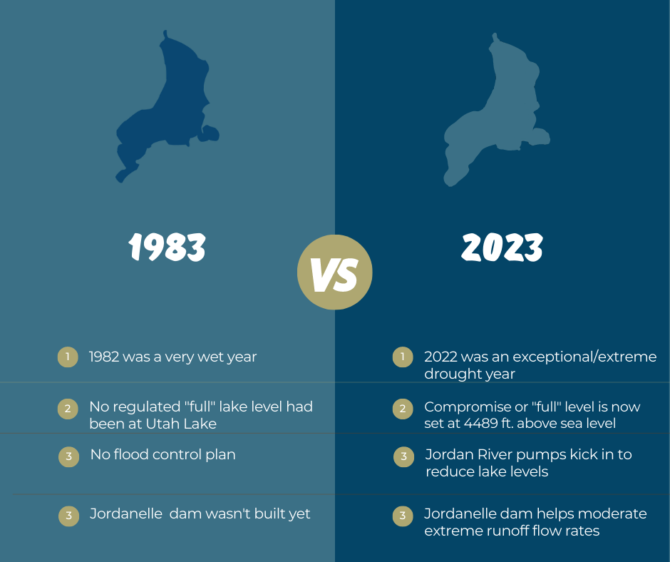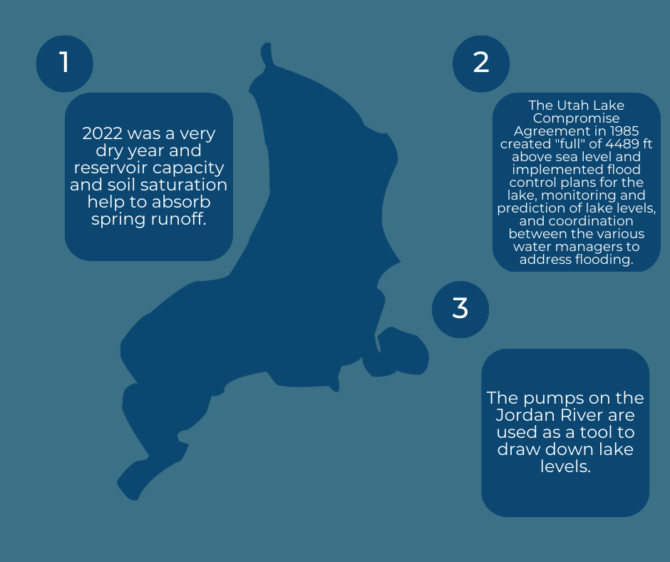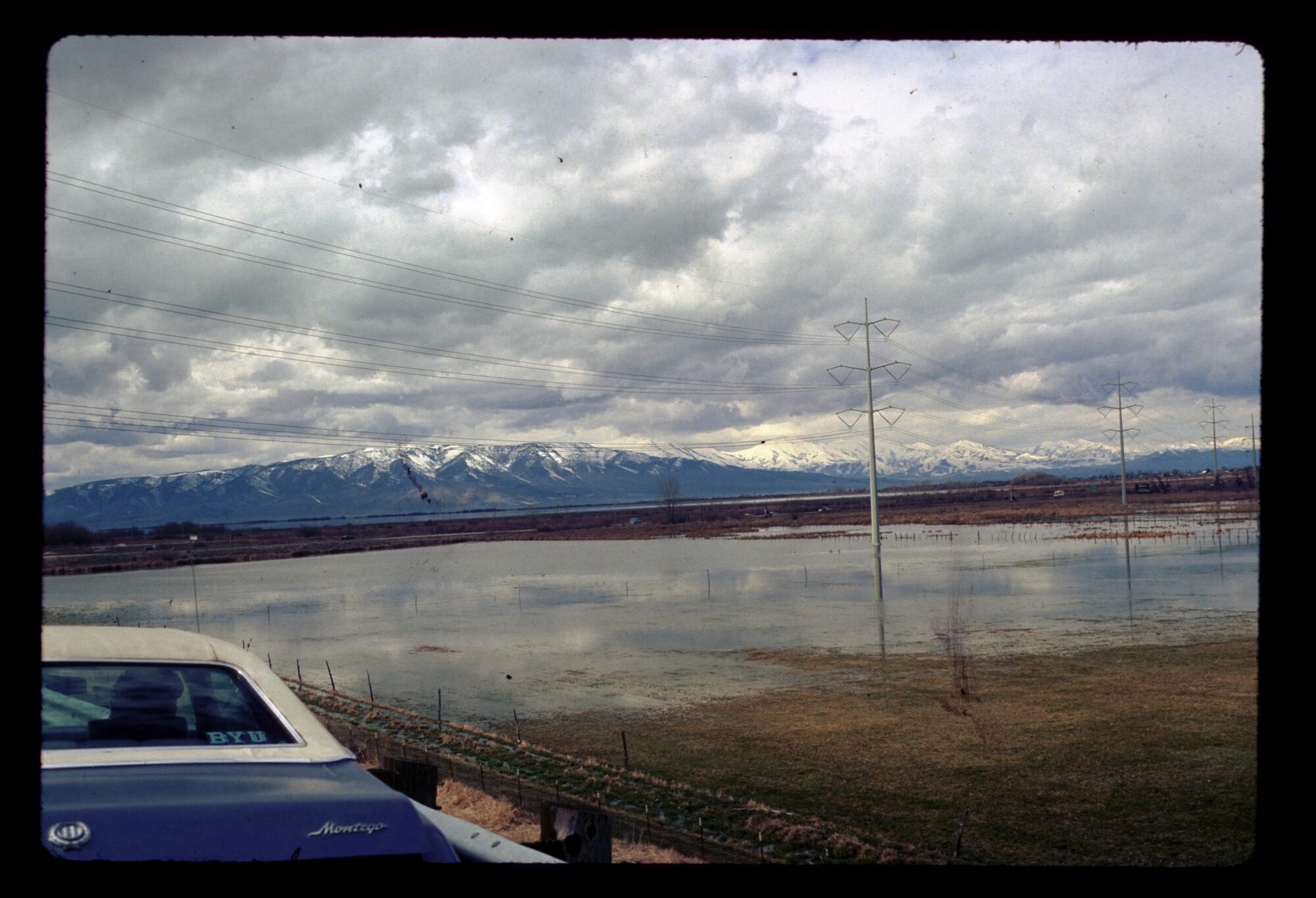With this season’s astounding snowpack, there have been concerns over flooding statewide. Utah Lake is no exception, but it’s not as bad as some may think. There have been substantial flood control improvements since the heavy 1983 flooding season. Continue reading to learn a little about the differences between the 1983 flooding and 2023. We’ve also included at the bottom some helpful resources for residents who live around Utah Lake.
History of Utah Lake Levels
Over the last 135 years, Utah Lake’s annual high and low levels have fluctuated an average of 2.97 ft. The last two times the lake hit “full” were in 2019 and 2011. The Water Levels page on UtahLake.org is a great resource for both live and historic water levels. The chart below shows the annual highs and lows at Utah Lake since 1884.
The GIS map for the Utah Lake Trail Plan also has a layer you can turn on and off to view the FEMA floodplain.
1983 vs 2023
There are several differences between the flooding situation in 1983 compared to the situation this year in 2023, as shown in the graphic below.

Utah Lake Compromise Agreement – 1983
The 1983 lawsuit regarding Utah Lake flooding, known as the “Utah Lake Drainage Basin” case, was a landmark legal case that resulted in significant changes in the way Utah Lake and its surrounding tributaries were managed. The lawsuit was filed by a group of property owners who had suffered damage from flooding caused by Utah Lake. They claimed that the State, Utah County, and other entities were responsible for the flooding due to their failure to properly manage the lake and its drainage basin.
The lawsuit alleged that the defendants had violated the Clean Water Act, the Rivers and Harbors Act, and the Federal Emergency Management Act, among other laws. The plaintiffs sought damages for the property damage they had suffered, as well as injunctive relief to prevent future flooding.
Outcomes of the Lawsuit
After a lengthy trial, the court found in favor of the plaintiffs and ordered significant changes to be made. The court ordered the defendants to:
- Implement a comprehensive flood control plan for the lake and its surrounding areas.
- Construct additional flood control structures, such as dikes, levees, and channels.
- Improve the maintenance of existing flood control structures.
- Develop a system for monitoring and predicting water levels in the lake.
- Improve coordination and communication among the various entities responsible for managing the lake and its drainage basin.
The court also ordered the defendants to pay damages to the plaintiffs for the property damage they had suffered.
The changes ordered by the court helped to reduce the risk of flooding in the area and improve the overall health of the lake. The case also set an important precedent for other lawsuits related to flooding and water management, emphasizing the importance of complying with federal and state laws and regulations related to these issues.
Flood Preparedness Today at Utah Lake
The graphic below illustrates the flooding prevention that occurs at the lake:

General Flooding Preparedness
The following article is a great list highlighting what you should do before a flood, during a flood and after a flood.
Utah flooding resource guide: What to do before, during and after a flood
The Utah Division of Emergency Management has a wealth of helpful resources on flooding on their website. Flood hazard maps, information on flood insurance, educational videos and more are available at their Be Ready Utah: Floods webpage
In summary,things are much better at Utah Lake than it was in 1983. Preparedness is still vitally important. Below are some resources from various organizations.
Resources
Provo River Floodplain maps and resources


To whom it may concern,
My name is Walter Fellmeth. I live near harbor bay at the south end of Saratoga Springs. I’ve been here for three years watching with consternation at the diminishing lake levels. Consequently I’ve also cheered every snow storm this glorious winter knowing it would help restore lake levels. I’m curious to know how much of a rise we can expect this year as a result. From what I can tell there has been a 2.5-3 ft rise so far judging by the jetty out here but it seems the lake could use another 5 feet. I’m wondering at what level the pumps kick on to “drain” the lake and send our water north to the GSL. If my vote counts I say cut the power to them. Thank you in advance for your response.
Walter Fellmeth
Walter,
Thanks for your comment. We appreciate your insights and hope you enjoyed the blog post on flooding preparedness at Utah Lake. The word going around is that Utah Lake will likely fill this year. As of today, the lake is sitting right around 3.25 feet below full.